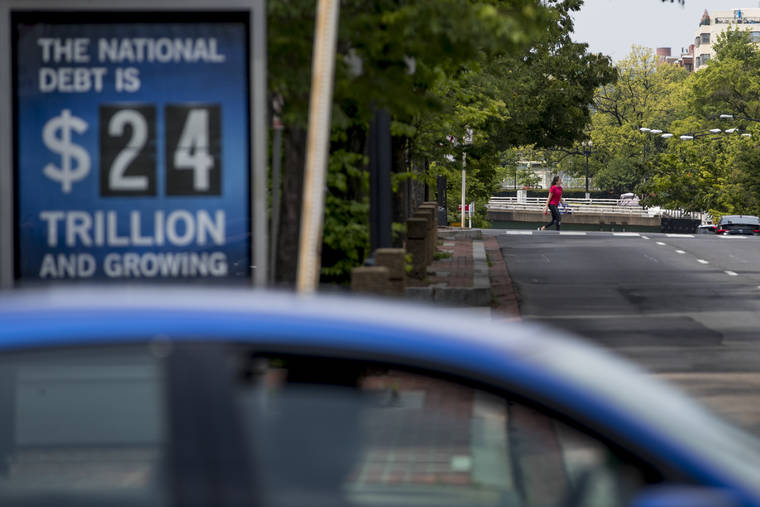WASHINGTON — The U.S. government’s war against the coronavirus is imposing the heaviest strain on the Treasury since America’s drive to defeat Nazi Germany and imperial Japan three-quarters of a century ago.
The Congressional Budget Office has warned that the government this year will run the largest budget deficit, as a share of the economy, since 1945, when World War II ended. Next year, the federal debt — the sum of the year-after-year gush of annual deficits — is forecast to exceed the size of the entire American economy for the first time since 1946. Within a few years, it’s on track to set a new high.
It might be surprising to hear that most economists consider the money well-spent — or at least necessary. Few think it’s wise to quibble with the amount of borrowing deemed necessary to sustain American households and businesses through the gravest public health crisis in more than 100 years. That’s especially true, economists say, when the government’s borrowing costs are super-low and investors still seem eager to buy its debt as fast as the Treasury issues it.
Here’s a closer look at the federal debt and the government’s use of it to combat the pandemic and the economic pain it’s inflicted.
JUST HOW MUCH MONEY ARE WE TALKING ABOUT?
The annual deficit — the gap between what the government spends and what it collects in taxes — will hit $3.3 trillion in the budget year that ends Sept. 30, the CBO projects. That amounts to 16% of America’s gross domestic product, which is the broadest measure of economic output. Not in 75 years has a deficit been that wide.
The federal debt, reflecting the accumulated deficits and the occasional surplus, is forecast to reach 100% of GDP next year. Then it is predicted to keep climbing to $24.5 trillion — 107% of GDP — in 2023. That would snap the record of 106% of GDP set in 1946. (The percentage does not include debts that the government agencies owe one another, including the Social Security trust fund.)
WHY IS THE BUDGET SO LOPSIDED?
The U.S. government was already deeply in debt even before the virus struck in March. The budget had absorbed the expenses of the 2007-2009 Great Recession, the federal benefits for the retirements of the vast baby boom generation and the cost of President Donald Trump’s 2017 tax cut. Last year, the debt burden reached 79% of GDP, the highest share since 1948.
Then came the pandemic. The economy tumbled into a sickening free-fall as businesses shut down and millions of Americans hunkered down at home to avoid infection. GDP collapsed at a 31.7% annual rate from April through June, the worst three months on records dating to 1947. In March and April combined, employers slashed a record 22 million jobs.
To help Americans to endure the crisis, Congress passed a $2 trillion relief bill in March. Among other things, the package sent Americans one-time checks of up to $1,200 and temporarily offered the unemployed $600 a week on top of their state jobless benefits.
Economists say that the rescue probably helped keep the economy from sinking into a depression but also that much more assistance is needed.
CAN THE U.S. REPAY ALL THAT MONEY?
After World War II, the United States paid down the federal debt with surprising speed. By 1961, the debt had dropped to 44% of GDP, the same level as in the prewar year of 1940.
Behind that success was a fast-growing economy that delivered rising revenue to the government and erased the debt. From 1947 through 1961 the economy grew at a 3.3% annual rate. The financial system was tightly regulated by the government. This allowed policymakers to keep interest rates artificially low and minimize the cost of repaying the debt.
Circumstances are somewhat different now. The economy doesn’t grow as fast as it did in the postwar boom years. Since 2010, GDP growth has averaged just 2.3%, even excluding this year’s economic implosion. And the government doesn’t control interest rates as it used to, not after the financial deregulation of the 1980s.
Still, the Federal Reserve is helping keep government borrowing rates ultra-low by buying up huge volumes of Treasury debt.
DOES THE DEBT CARRY ECONOMIC CONSEQUENCES?
Economists have long warned that too much government borrowing risks hobbling the economy. When the government takes on excessive debt, the argument goes, it competes with businesses and consumers for loans, thereby forcing borrowing rates prohibitively high and imperiling growth.
Another concern is that investors will demand ever-higher interest rates for accepting the risk that governments could default on their debts.
Some economists and budget watchers still warn that a day of reckoning will come and that the United States will have to curb spending, raise taxes or both.
But after the Great Recession, many economists began to rethink their view of debt. The recovery in the United States and especially in Europe was sluggish in part because policymakers were too reluctant to stimulate growth with debt.
In the United States, rates didn’t rise even though government debts were high. Investors, it turned out, had a near-insatiable appetite for U.S. Treasurys, still considered the world’s safest investment. Their rush to buy federal debt helped keep rates low and limited the government’s borrowing costs. So did persistently low inflation.
In such a low-rate, low-inflation environment, the risk of piling on more debt seems more manageable, at least for countries like the United States and Japan that borrow in their own currencies.
In a speech last year, Olivier Blanchard, a former chief economist of the International Monetary Fund, declared:
“Put bluntly, public debt may have no fiscal cost … The probability that the U.S. government can do a debt rollover, that it can issue debt and achieve a decreasing debt-to-GDP ratio without ever having to raise taxes later, is high.”
———
AP Economics Writer Martin Crutsinger contributed to this report.


